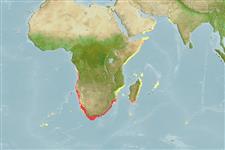Common names from other countries
Elasmobranchii (sharks and rays) >
Rajiformes (Skates and rays) >
Rajidae (Skates)
Etymology: Leucoraja: Greek, leykos = white + Latin, raja = a fish, Raja sp. (Ref. 45335).
Environment: milieu / climate zone / depth range / distribution range
Ecology
Marine; brackish; bathydemersal; depth range 70 - 517 m (Ref. 106604). Deep-water
Southeast Atlantic and Western Indian Ocean: Lüderitz, Namibia round the Cape (South Africa) to southern Mozambique.
Size / Weight / Age
Maturity: Lm ? range ? - ? cm
Max length : 100.0 cm TL male/unsexed; (Ref. 11284)
Short description
Identification keys | Morphology | Morphometrics
A distinctive skate with bright yellow spots, often in rosettes and whorls and sometimes forming eye-like markings on pectoral bases (Ref. 5578). Snout short, broad and blunt, disc narrow, and tail longer than body; disc very rough with 2-4 rows of thorns from midback to 1st dorsal fin, and with broadly rounded corners (Ref. 5578). Yellowish brown above, white below; some grey-brown above with white spots (Ref. 5578).
Found in offshore areas on soft bottoms (Ref. 5578). Feed on bony fish and benthic invertebrates (Ref. 5578). Oviparous. Distinct pairing with embrace. Young may tend to follow large objects, such as their mother (Ref. 205). Eggs are oblong capsules with stiff pointed horns at the corners deposited in sandy or muddy flats (Ref. 205). Egg capsules are 7.3 cm long and 4.2 cm wide (Ref. 41249). Caught by hake trawlers (Ref. 5578).
Life cycle and mating behavior
Maturities | Reproduction | Spawnings | Egg(s) | Fecundities | Larvae
Oviparous, paired eggs are laid. Embryos feed solely on yolk (Ref. 50449). Distinct pairing with embrace. Young may tend to follow large objects, such as their mother (Ref. 205).
McEachran, J.D. and K.A. Dunn, 1998. Phylogenetic analysis of skates, a morphologically conservative clade of elasmobranchs (Chondrichthyes: Rajidae). Copeia 1998(2):271-290. (Ref. 27314)
IUCN Red List Status (Ref. 130435)
CITES (Ref. 128078)
Not Evaluated
Threat to humans
Harmless
Human uses
Fisheries: of no interest
Tools
Special reports
Download XML
Internet sources
Estimates based on models
Preferred temperature (Ref.
115969): 9.3 - 17.9, mean 11.3 (based on 65 cells).
Phylogenetic diversity index (Ref.
82804): PD
50 = 0.5000 [Uniqueness, from 0.5 = low to 2.0 = high].
Bayesian length-weight: a=0.00363 (0.00249 - 0.00530), b=3.25 (3.14 - 3.36), in cm Total Length, based on LWR estimates for this species & Genus-body shape (Ref.
93245).
Trophic level (Ref.
69278): 3.9 ±0.64 se; based on food items.
Resilience (Ref.
120179): Low, minimum population doubling time 4.5 - 14 years (Fec assumed to be <100).
Fishing Vulnerability (Ref.
59153): High vulnerability (60 of 100).
